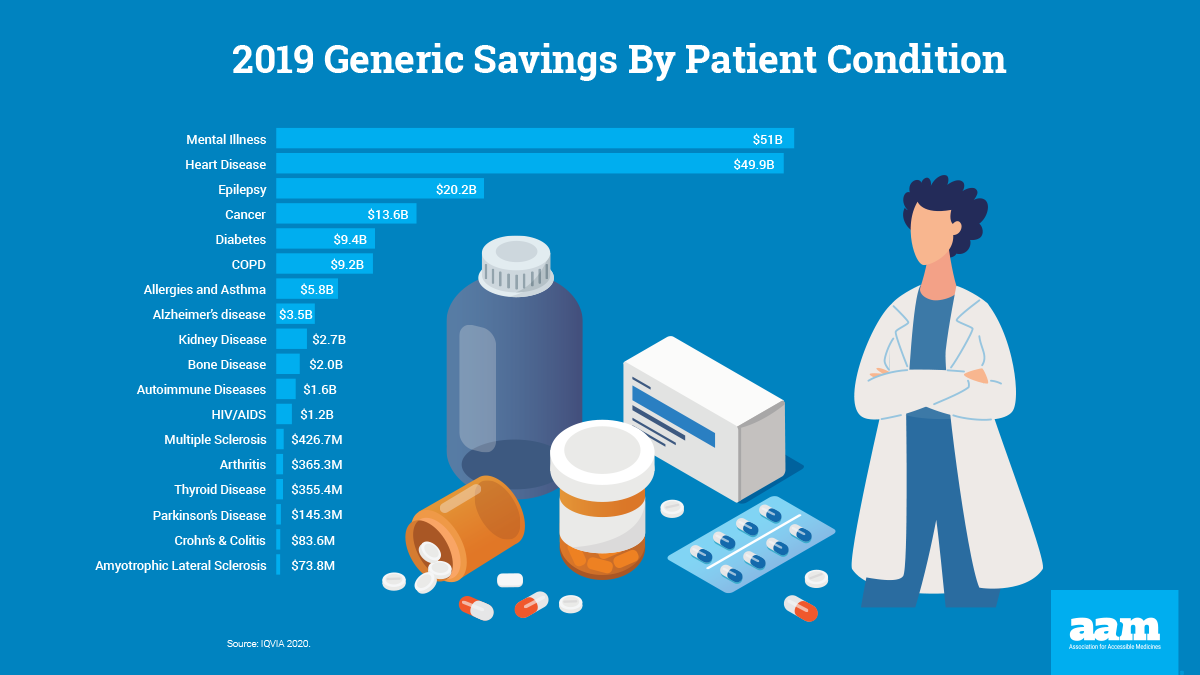Every year, the Association for Accessible Medicines (AAM) publishes a report demonstrating how much U.S. patients and our overall health care system save through the use of generic prescription drugs. As the newly released edition shows, the savings grow every year, totaling $313 billion in 2019 and close to $2.2 trillion over the past decade.
Each dollar saved represents an American patient with a health condition impeding the ability to lead a full and productive life—or even threatening life. AAM releases detailed information specific to the conditions for which the savings are greatest. Here are some of the highlights:
- According to the National Cancer Institute, there are approximately 1.7 million new cases of cancer in the United States each year, and more than 609,000 cancer-related deaths annually. Total savings from generic cancer drugs came to $13.6 billion in 2019 and $87.8 billion over the past 10 years.View Cancer Fact Sheet.
- The American Academy of Allergy, Asthma & Immunology estimates that 25 million Americans have asthma. Savings for these patients, together with those who have allergies, totaled $5.8 billion in 2019 and $36.1 billion over the past 10 years. View Allergy & Asthma Fact Sheet.
- The Centers for Diseases Control and Prevention (CDC) estimates that 3 million adults and 470,000 children are living with epilepsy. Generics saved them $20.3 billion in 2019, and savings for the past 10 years total $149.1 billion.View Epilepsy Fact Sheet.
- According to the CDC, 16 million Americans have Chronic Obstructive Pulmonary Disease (COPD), the third-leading cause of death in the United States. In 2019, generics saved these patients $9.2 billion, and savings for the past 10 years total $60 billion.View COPD Fact Sheet.
- More than 5 million Americans are living with Alzheimer’s disease, the sixth leading cause of death, according to the Alzheimer’s Association. Generics saved Alzheimer’s patients $3.5 billion in 2019, and savings for the past 10 years total $22.2 billion.View Alzheimer’s Fact Sheet.
The global COVID-19 pandemic has layered new health care challenges on top of the diseases Americans confront, and AAM will continue to monitor the savings made possible by generic and biosimilar medicines. These savings play a substantial part in America’s health security.
View All Condition Savings Fact Sheets


By Sara Skubikowski, AAM Senior Director of Strategic Alliances
AAM 2010-2019 Patient Savings Report: Methodological Overview
This report estimates savings from generic drugs for the 10 year period between 2010 and 2019, as well as a single-year estimate for 2019.
Base Savings Estimates: The base savings were calculated by IQVIA. We generated condition-level savings by assigning drugs to a list of common conditions and aggregating savings for all drugs that are used to treat these conditions. Product condition assignments were conducted by a Doctor of Pharmacy. Importantly, many products treat multiple conditions. For this analysis, we ensured that the most common use of the product was the condition into which it was assigned.
Comorbidity Estimates: We used published epidemiological data to determine the three most common comorbidities for each of the index conditions. We calculated the base savings for the primary condition in the same manner as described above and assigned a weighted savings to each of the three selected comorbid conditions based on published prevalence data. Because the IQVIA data provided units rather than patients, we used units as a proxy for the number of patients treated and adjusted the units, and thus savings, in proportion to the published prevalence of each comorbid condition. Importantly, this methodology, due to the differences in units utilized by patients for specific conditions, could occasionally lead to estimates of comorbidity savings that exceed the total savings for that stand alone condition. In these cases, the savings were either capped, when the total numbers were relatively low relative to the main condition or, more commonly, the incidence rate for the comorbidity was applied again, to ensure a lower savings estimate. While this is a methodological choice and likely underestimates the savings from the comorbidity, it effectively assumes that the commorbidity requires more units per patient treated than the main condition.

